In 100 years, economists and historians will look back on the late 1990s and early 2000s as the foundational years of the on-demand phenomenon. And they will be right to do so.
The Rise Of The On-Demand Economy
In 100 years, economists and historians will look back on the late 1990s and early 2000s as the foundational years of the on-demand phenomenon.
And they will be right to do so.
The past couple decades have given life to a full-fledged movement. Everyone remembers the glory days of AOL Instant Messenger, allowing for instantaneous communication online—and nobody denies the ways in which companies like Amazon have changed the way we look at e-commerce, shipping and warehousing logistics.
Really, that’s just the tip of the iceberg.
The on-demand economy is here to stay—but its existence today is barely a fraction of what it will grow to be.
In the midst of massive innovation in the fields of on-demand delivery, transportation, and supply chain, it’s important to consider what sort of impact these changes will have on the future of the companies involved and those that are yet to enter the market.
We’ve compiled a list of 12 compelling statistics that shed light on the impact of the on-demand economy and where we may be headed in the future.
We will also explore the implications of all of this innovation on companies operating in the Transportation industry as well as how veteran companies can adapt and continue to succeed.
Buckle up!
Jump straight to the statistics
Consumers Have Always Wanted On-Demand Transportation And Delivery
The technology that serves as the backbone for our on-demand economy may be new and groundbreaking, but the reason for the industry’s existence is nothing new.
In fact, a desire for immediate gratification and efficiency is ingrained in human nature.
Before Uber, Facetime and Amazon Prime—between 1438AD and 1532AD, to be exact—the Inca Civilization of South America had its own answer to the need for haste in the delivery of goods and messages.
The Inca used fast men known as the Chasqui Runners to run quickly between cities as messengers and couriers.
While the Chasqui runners were incredibly efficient at delivering urgent warnings of village uprisings and political messages, this wasn’t their only purpose.
The runners were also used to quickly deliver luxury goods to the Emperor, as well as merchants. In fact, they were able to carry fresh fish from the coast to the emperor in just two days.
That’s great, but what does that have to do with today’s on-demand economy?
Well, we could argue that history makes the trajectory of our current on-demand economy even more compelling.
It tells us that the ideals behind things like same-day delivery, ecommerce, and ridesharing, are born out of a piece of human nature that has always been there:
A desire for immediate gratification.
The difference is that today, we have the technology and the means to make it happen.
Let’s Explore Our On-Demand World And Its Implications:
51% of global retailers offer same-day delivery.
What it means
That may not seem huge, until you realize that last year at this time, that number was 15 percent, meaning it has more than tripled in one year!
The improvement in how companies cater to new buyer preferences has been far-reaching and prompt.
How long until we hit 100%?
That may take a while—as research shows that the number is projected to be 65% by 2019—but we are well on our way.
60% of US consumers would pay more than $10 to get furniture delivered on the day it was ordered.
What it means
It really doesn’t seem insane:
“$10 to be able to enjoy a piece of furniture in my house the day I buy it? No brainer!”
But that just speaks to how pervasive our desire for immediacy has become. And that’s not a bad thing!
In a similar example, the graph below, provided by Business Insider shows us that consumers around the world are willing to pay more for convenience in food preparation and delivery:
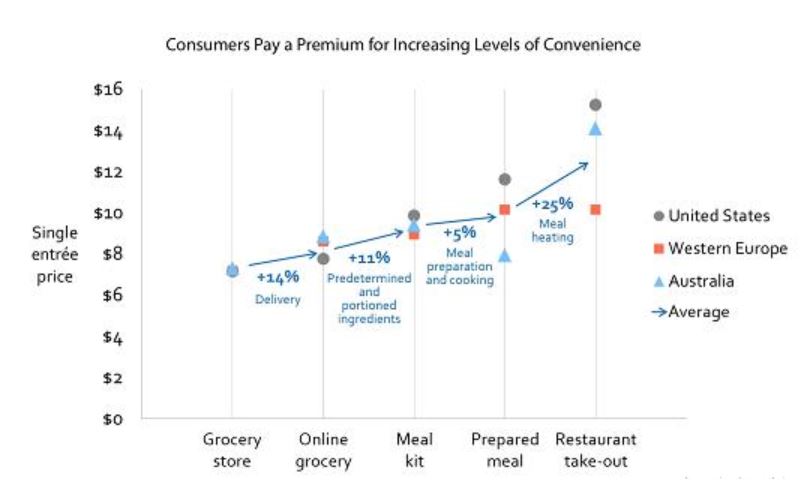
20 years ago, we were fine sitting in front of our computer for 5 minutes waiting for our dial-up internet to connect. We didn’t love it, but it was the only option.
In 2018, with the technological advancements or recent years, we don’t have to sit around on the floor for 3 weeks while we wait for our new couch to be delivered.
According to WIRED,
“The logistics required for making same day delivery a reality are daunting. Supply chain, delivery, customer support, advanced eCommerce software and warehouse facilities are all crucial to making the new tactic a reality. Amazon for instance, is revamping their logistical operations as shown by their recent acquisition of robotics company Kiva Systems.“
Technological innovation is never easy, but in the world of logistics and on-demand delivery, it can change the world.
Soon enough, waiting more than a day for furniture delivery will sound crazy.
In 2018, the order value of same-day delivery merchandise is projected to reach 4.03 billion U.S. dollars, up from 0.1 billion U.S. dollars in 2014.
What it means
That’s about a 4,000% increase, if anyone’s counting.
Here’s a graph from Statista that demonstrates that growth since 2014:
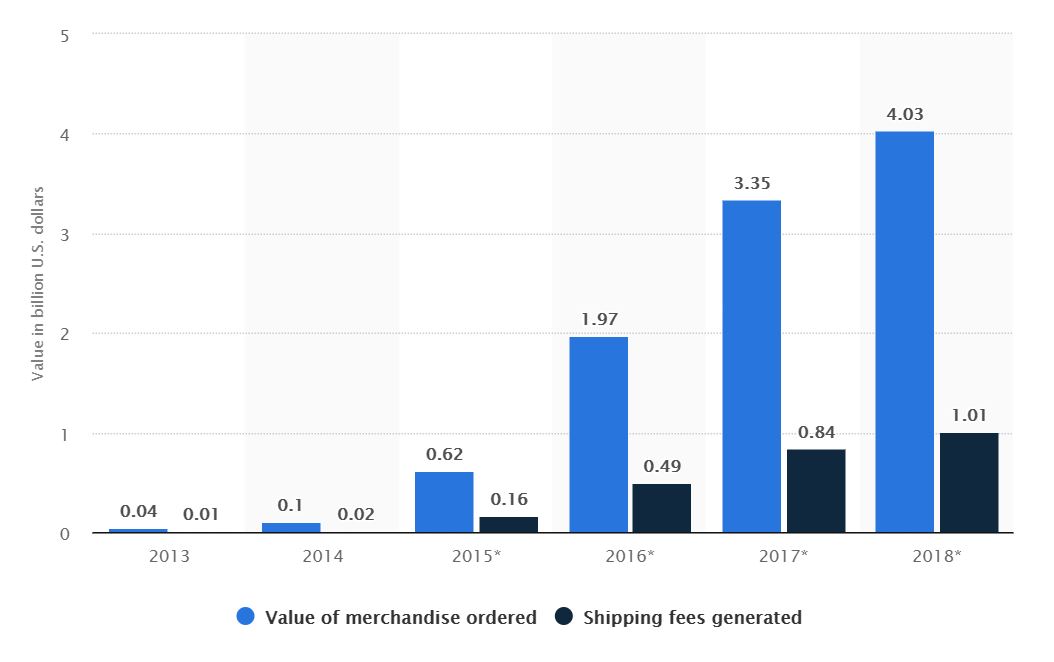
The graph also shows us that shipping fees generated follow a similar (albeit not as drastic) upward trend as value of merchandise ordered, suggesting that as same day delivery becomes more prominent, shippers are finding ways to increase their efficiency and cut costs.
In 2018, shipping fees generated from same day delivery of merchandise are projected to hit $1.1 Billion, up from $840,000,000 in 2017.
The on-demand economy is attracting more than 22.4 million consumers annually and $57.6 billion in spending.
What it means
If the on-demand economy is worth $57.6 Billion and same-day delivery “only” accounts for $4.1 Billion of that, where are the rest of those dollars coming from?
This graph from Harvard Business Review shows us a breakdown:
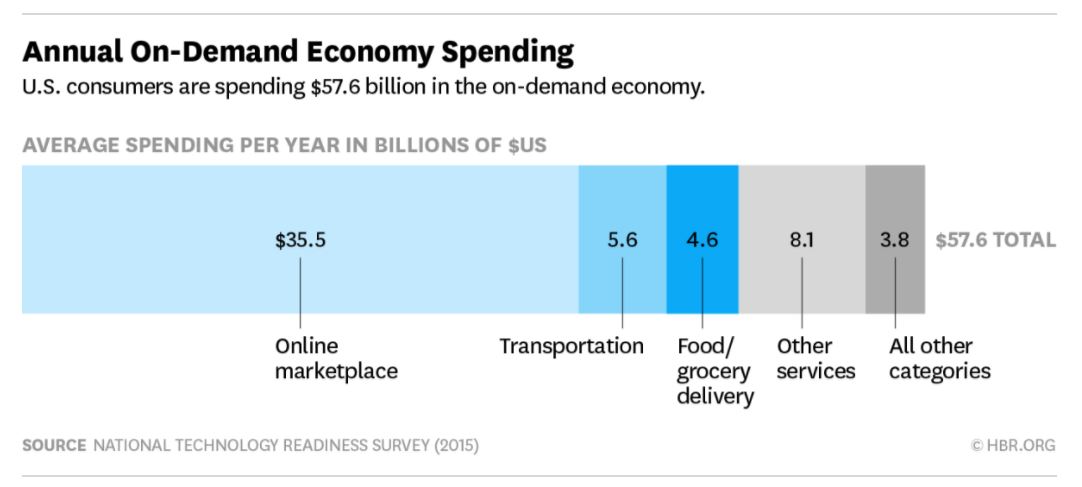
Online shopping dominates the list, followed by transportation (companies like Uber and Lyft) and food/grocery delivery.
The majority of customers – 49 percent – are millennials, while 30 percent are between the ages of 35 and 54.
What it means
In the same study as the statistic above, HBR identifies on-demand spending by age group (shown in the figure below):
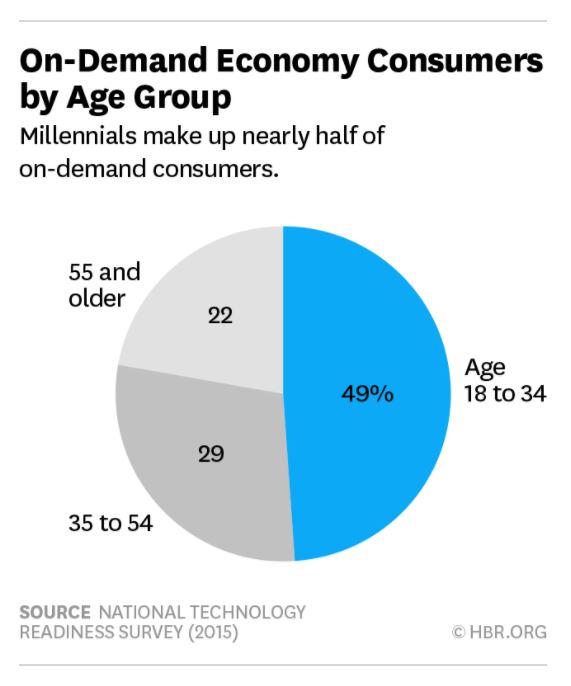
The prevalence of Millennial consumers suggests that the on-demand economy has nowhere to go but up as more Millennials enter the workforce and accumulate wealth.
46 percent of consumers have an annual household income of less than $50,000.
What it means
This may be the most eye-opening statistic.
On-demand delivery and services are often associated with higher cost.
While this is typically true, it doesn’t seem to be much of a factor in terms of defining which income brackets are more likely to pay a premium to experience good and services on-demand.
More likely, the emergence of on-demand has changed the way that people look at the consumption of goods and services.
The universal adoption of on-demand suggests that it is becoming more of a “need” than a “want.”
In the Transportation industry, investments in On-Demand over the past 12 months are triple the amount of investments made in the previous 4 years combined.
What it means
The graph below from Business Insider shows investments made over the past 5 years next to those made in the past 12 months in a variety of different industries.
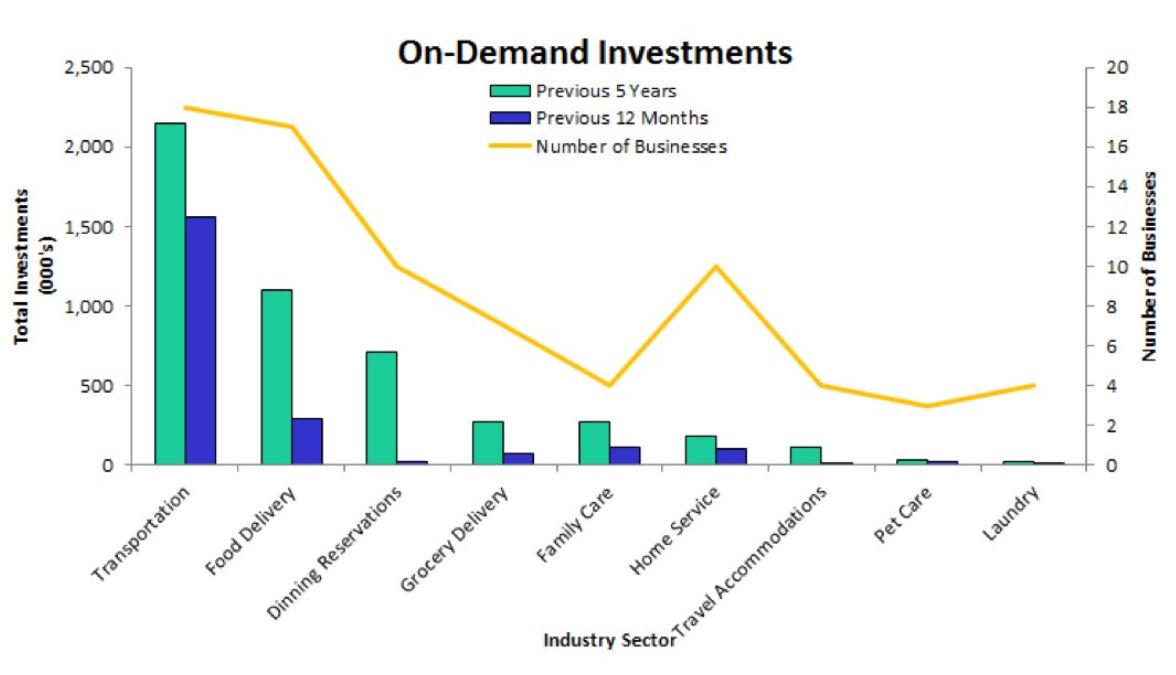
Growth within the on-demand delivery and transportation industry is very representative of the massive disruption brought about by the on-demand economy.
There has been exponential increase both in funds invested and in the number of businesses getting involved over the past 5 years.
72% of Americans have used on-demand services.
What it means
Here’s the breakdown of how the services have been used:
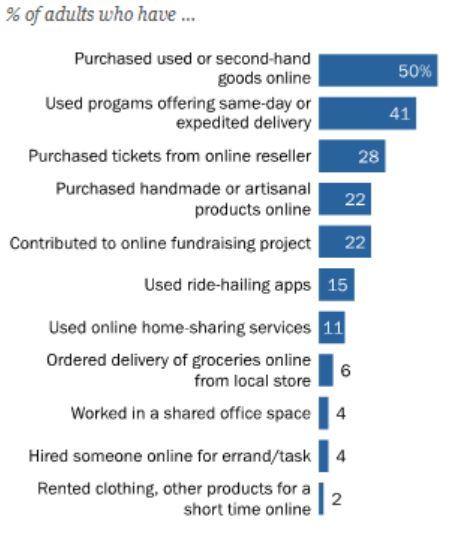
These uses speak to just how pervasive the phenomenon has become.
Even so, the age-group and income statistics above suggest that this number will go up considerably in the coming years.
18% of consumers cite fast delivery as the biggest factor in choosing their “favorite” store.
What it means
18% isn’t a huge number, but the fact that 18% of people believe fast delivery is a more important factor than things like quality or type of merchandise is unbelievable.
It only speaks to just how significant on-demand delivery and same-day shipping have become.
As same-day shipping becomes more and more prevalent, companies that fail to adapt will begin to suffer, as buyers are showing that they prefer to buy something similar they can get right away rather than wait an extended period of time.
Over 50% of online businesses plan on providing same-day delivery in the next 3-5 years.
What it means
Clearly, businesses have begun to understand that they need to adapt to buyer preferences.
While companies like Amazon have disrupted the world of retail, they have also raised the bar, creating a notion that customers shouldn’t necessarily be forced to settle for anything less.
The value of items delivered same-day in the US is projected to increase 40x in the next 4 years.
What it means
As we discussed above, nobody uses dial-up internet anymore, because they don’t have to.
The demand for same-day delivery in the United States and worldwide suggests that other types of delivery will be just as obsolete in the near future.
26% of US online shoppers abandon their shopping carts due to shipping times being too long.
What it means
This is another great example of how buyer behavior has been modified through innovation.
Longer wait times translate into less customer loyalty. Less customer loyalty implies bleak futures for companies unable to improve their logistics.
